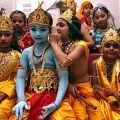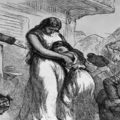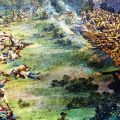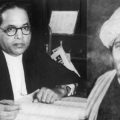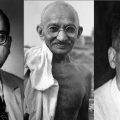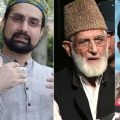Will Indians Place Country Above Creed? – Dr. Ambedkar; Framing of Indian Constitution
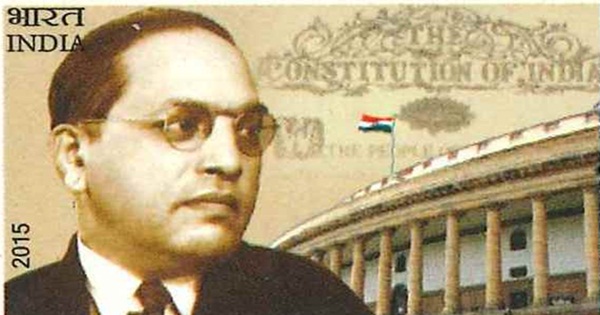
The task of framing the Constitution of a nation is performed, generally, by a body of Representatives. Such a body is elected by the people. Such body of Representatives then adopt the design within which the framework of the Constitution needs to be installed and may be known or called as the “Constituent Assembly”.
Constituent Assembly
In India, the idea of Constituent assembly had evolved with the national movement. The idea of a Constituent assembly, whereby Indians shall have the right to frame their own Constitution for their country, was implicit in the resistance to the 1919 act. Though, the first concrete reference to a Constituent assembly for India, was made by none other than Mahatma Gandhi in 1922, soon after the inauguration of India Act, 1919.
A joint meeting of members of the two houses of the Central Legislature was held at Shimla in 1922 convened by Mrs. Annie Besant, therein it was decided to call for a convention for framing of a Constitution. There was another conference held in Delhi in 1923, February attended by members of the Central and Provincial legislatures. This conference outlined essential elements of a Constitution equating India on Similar footing with the self Governing Dominions of the British Empire.
On 24th April, a “National Convention” met under the presidentship of Sir Tej Bahadur Sapru. This convention led to the drafting of the ” Commonwealth of India Bill”. The draft bill was slightly amended and then submitted to a committee of the all parties conference held at Delhi in January 1925 , presided over by Mahatma Gandhi. Eventually, the draft bill was submitted to a drafting Committee which subsequently published the Bill. The Bill was also sent to an influential member of the Labour party in Britain along with a memorandum signed by 43 leaders of Various political parties. The Bill was widely accepted within the Labour party with slightest modifications. The Bill was introduced in the House of Commons and was read. Though, the defeat of the Labour government sealed the fate of the bill, it was the first major effort by the Indians to outline a Constitutional scheme for India by adopting peaceful and Constitutional means.
The adoption of the Motilal Nehru resolution in 1924 and 1925 owing to national demand was a historic event, as for the first time, the central Legislature had extended its support to the pressing and legitimate demand that the future Constitution of India should be framed by Indians themselves.
In 1927, November, an all-party meeting was held at Allahabad in detest to the appointment of the Simon Commission. In the said meeting, it was said that apart from being virtual negation of the “National Demand”, The commission amounted to a “deliberate insult to the People of India”, for, not only did it ” definitely assign to them a position of inferiority” but also denied to them “the right to Participate in the determination of the Constitution of their own Country”.
On 17th May, 1927, at the Congress Bombay Session, Motilal Nehru moved a resolution calling upon the Congress Working Committee to frame a Constitution for India after consulting with the elected members of the Central and Provincial Legislatures and leaders of the other political parties. The Resolution was adopted with amendments by an overwhelming majority. This resolution on the Swaraj Constitution was later amplified and reiterated by Jawaharlal Nehru in a Resolution passed in the Madras session of the Congress on 28th December, 1927. An all-Parties conference was organized at Bombay on 19th May, 1928, The conference appointed a committee, under the chairmanship of Motilal Nehru “to determine the principles of the Constitution”. The report prepared by the committee (submitted on 10th August, 1928) subsequently became famous as the ” Nehru Report”. It was the first full fledged attempt by Indians to frame a Constitution for their own nation as been described by Copuland as “not only an answer to the challenge that Indian nationalism was unconstructive” but ” frankest attempt yet made by Indians to face squarey the difficulties of communalism”. The report reflected the principle that sovereignty belongs to the indian people, laid down a set of Rights (Fundamental Rights) and advocated for a federal structure with maximum autonomy granted to the provinces but the residuary power residing with the central Government and Joint electorates for elections to the Federal Lower House and the Provincial Legislatures with reservation for minorities in specific cases for a given period.
The White paper issued subsequently to the third round table conference incorporated the government’s proposal with regard to Constitutional reforms in India. The Joint Parliamentary Committee examining the proposals observed that ” a specific grant of Constituent power to authorities in India is not at the moment a practicable proposition”.
The failure of the Simon Commission and the breakdown of the Round Table Conference led to the enactment of the Government of India Act, 1935 satisfying Indian aspirations for their own Constitution and further accentuating the demand for a Constituent assembly of the people of India. The Congress, at its Lucknow Session in April, 1936 adopted a resolution which declared that no Constitution imposed by an outside authority shall be acceptable to India and Indian people; The same has to be framed by an Indian Constituent assembly reflecting the aspirations and desires of the Indian people.
After the Second World War broke out in 1939, the demand for a Constituent Assembly elected by the people of India on adult franchise was reiterated in a long and elaborate statement issued by the Congress Working Committee on 14th September, 1939.
Gandhiji wrote an article entitled “The Only Way” in the Harijan on 19th November, 1939 In which he expressed “Constituent assembly alone can produce a Constitution indigenous to the country and truly and fully representing the will of the people.”
The British government for the first time conceded the demand for a Constituent assembly on behalf of the Indians though with significant reservations known as the “August offer” of 1940. The Cripps proposal seemed to be an extension of the “August offer” in nature that the framing of the new Constitution now rested solely upon Indian hands and not mere ” Primarily” and the same was in the nature of a clear undertaking given by the British government to accept the Constitution designed by the Constituent Assembly. The Cripps Mission resulted as a failure and thereafter no concrete steps were taken on behalf of the British government until the war that raged in Europe came to an end in May, 1945.
In July, a new labour government came in power in England, the policy of the new government towards India was announced on 19th September 1945 by Lord Wavell who succeeded Lord Linlithgow as Viceroy in 1943. The Viceroy affirmed His Majesty’s intention to convene a Constitution-making body “as soon as possible”.
The Cabinet Mission realised that the most prudent method to architect a Constituent assembly would have been by election on the basis of Adult franchise, but the same would have caused ” a wholly unacceptable delay” in the making of the new Constitution. ” The only practicable course” according to them was, “to utilise the recently elected Provincial Legislative Assemblies as electing bodies”, As they claimed the ” fairest and as most practicable plan” in the given circumstances, the mission recommended that the representation of the provinces in the Constituent assembly be on the basis of population, roughly in the ratio of one member to a million and the seats allocated to the provinces be divided among the principal communities, as classified for the purpose as Sikhs, Muslims and General ( all except Muslims and Sikhs), on the basis of their numerical strength. The representatives of each community to be decided by the members of that community in the Provincial assembly and voting was to be by the method proportional representation with single transferable vote. The number of members that was to be allotted to the Indian States was to be ascertained on the basis of Population as adopted during British India, though the procedure of their selection to be decided later by consultation. The Constituent Assembly was to have the strength of 389. Now, out of this strength of 389 members, 296 representatives were to be drawn from British India, ( 292 representatives drawn from the eleven Governor’s provinces of British India and a representative each from the four Chief Commissioners’ Provinces of Delhi, Ajmer- Merwara, Coorg and British Baluchistan) and 93 representatives were to be drawn from the Indian States.
The Cabinet Mission recommended a basic framework for the Constitution and laid down elaborately the procedure to be adopted by the Constituent assembly.
The Elections for the 296 seats assigned to the British- Indian provinces were completed by July- August 1946. The breakup of the results are hereinafter mentioned :
Congress – 208
Muslim League -73
Unionist – 1
Unionist Muslim – 1
Unionist Scheduled Castes – 1
Krishak Praja – 1
Scheduled Castes Federation – 1
Sikh ( Non- Congress) – 1
Communist – 1
Independents – 8
Grand Total – 296
Owing to the independence of the country and the partition, on 14-15 August 1947, the Constituent Assembly of India became a Sovereign body. In other words, The Constituent assembly became the successor to the British Parliament’s plenary authority and power in the Country. Further, in pursuance of the acceptance of the plan of 3rd June, the members of the Muslim League party from the Indian Dominion entered the Constituent assembly. The representatives of some of the other Indian States had already made the assembly on 28th April, 1947. By 15th August, 1947 majority of the States had their representatives in the assembly and the remaining states followed soon.
In other words, the Constituent Assembly became a body, truly representative of the States and provinces of India, reflecting the aspirations and dreams of millions of Indians and fully sovereign of all external authority. The Constituent Assembly had the power to abrogate or alter any law made by the British Parliament applying to India, including the Indian independence act.
The Constituent assembly duly opened on 9th of December, 1946 at eleven in the morning (the appointed time and date). On 13th December 1946, Pandit Nehru moved the historic Objectives Resolution in the Constituent assembly after the same had been in session for some days. In the words of Subhas.C. Kashyap, the eminent constitutional historian and Political scientist “The beautifully worded draft of the Objectives Resolution cast the horoscope, so to say, of the Sovereign Democratic Republic that India was to be. The resolution envisaged a federal polity with the residuary powers vesting in the autonomous units and sovereignty belonging to the people. ” Justice, social, economic and Political; Equality of Status, of opportunity and before the law; Freedom of thought, expression, belief, faith, worship, vocation, association and action” were to be guaranteed to all the people along with ” adequate safeguards” to “minorities, backward and tribal areas and depressed and other backward classes”. Thus, the resolution gave to the assembly it’s guiding principles and the philosophy that was to permeate its tasks of Constitution making”.
The historic Objectives Resolution was finally adopted by the assembly on 22nd January, 1947. Later, Objectives Resolution took the shape of the Preamble to the Constitution.
Framing of the Constitution
The Constituent Assembly appointed various Committees to cope with the different aspects of framing of the Constitution. These included the Union Constitution Committee, Union Powers Committee, Committee on Fundamental Rights, Minorities, etc. Some of these Committees were supervised either by Nehru or Patel to whom the President of the assembly gave the credit for devising out the fundamentals of the Constitution. The Committees worked in a professional manner and submitted their valuable reports. Between the third and sixth sessions, the Assembly considered the reports of Committees on Fundamental Rights, on Union Constitution, or Union Powers, on Provincial Constitution, on minorities and in scheduled Areas and Scheduled Tribes. Recommendations given by the various other Committees were considered by the drafting Committee in due time.
The first draft of the Constitution was prepared by the Advisory Branch of the office of the Constitution Assembly under Sir B.N.Rau in October, 1947. The preparation of this draft was owing to voluminous background material collected and supplied to the members of the assembly in the shape of three series of “Constitutional Precedents” which included salient texts from the Constitutions of almost 60 Countries. On 29th August, 1947 the Constituent assembly appointed the Drafting Committee with D.R. B.R. Ambedkar as the Chairman to evaluate the draft of the Constitution of India prepared by the Constitutional advisor (B.N. Rau) giving effect to the decisions taken in the assembly.
On 21st February, 1948 the draft Constitution prepared by the Drafting Committee was submitted to the President of the assembly. Soon, Comments, criticisms and suggestions for the amendment of the Draft Constitution were received. The Drafting Committee took into consideration all these. A special Committee was constituted to scrutinize them read with the recommendations of the Drafting Committee thereon. The suggestions given by the Special Committee were again considered by the Drafting Committee and certain amendments were selected for incorporation. The Drafting Committee to facilitate reference to such amendments decided to issue a reprint of the Draft Constitution submitted to the President of the Assembly on 26th October, 1948.
On 4th November, 1948, Dr. B.R. Ambedkar while introducing the Draft Constitution in the Assembly for consideration replied to some common criticisms of the Draft, especially and particularly to the criticism with regard to there being very little in the Draft Constitution that can be claimed original. He observed:
“One likes to ask whether there can be anything new in a Constitution framed at this hour in the history of the World. More than Hundred years have rolled over when the first Written Constitution was drafted. It has been followed by many Countries reducing their Constitutions to writing. What the Scope of a Constitution should be has long been settled. Similarly what are the fundamentals of a Constitution are recognised all over the world. Given these facts, all Constitutions in their main provisions must look similar. The only new things, if there can be any, in a Constitution framed so late in the day are the variations made to remove the faults and to accommodate it to the needs of the Country. The charge of Producing a blind copy of the Constitutions of other countries is based, I am sure, on an adequate study of the Constitution. As to the accusation that the Draft Constitution has produced a good part of the provisions of the Government of India Act, 1935, I make no apologies. There is nothing to be ashamed of in Borrowing. It involves no Plagiarism. Nobody holds any patent rights in the fundamental ideas of a Constitution.”
The Clause wise reconsideration of the Draft Constitution was completed during15th November, 1948 – 17th October, 1949. The preamble was last to be adopted. The Drafting Committee, thereafter, carried out the necessary amendments, prepared the final draft and placed it before the Assembly.
On 16th November, 1949 the second reading of the Constitution was completed and on the next day the assembly took up the third reading of the Constitution, with a motion by Dr. Ambedkar “that the Constitution as settled by the assembly be passed”. The Motion was adopted on 26th November, 1949 and therefore on that day, the people of India adopted, enacted and gave themselves the Constitution of the Sovereign Democratic Republic of India.
The adoption of the Constitution was the beginning of a new Journey. The Chairman of the Drafting Committee, Dr. Ambedkar, and the president of the assembly, Dr. Rajendra Prasad, Speaking on 25th and 26th November 1949 sounded words of caution and wisdom. Dr. Ambedkar observed:
“I feel, However good a Constitution may be, it is sure to turn out bad because those who are called to work it, happen to be a bad lot. However bad a Constitution may be, it may turn out to be good if those who are called to work it, happen to be a good lot. The working of a Constitution does not depend wholly upon the nature of the Constitution. The Constitution can provide only the organs of State such as the Legislature, the Executive and the Judiciary. The factors on which the working of those organs of State depends are the people and the Political parties they will set up as their instruments to carry out their wishes and their politics. Who can say how the people of India and their Parties will behave?
In addition to our old enemies in the form of Castes and creeds we are going to have many political parties with diverse and opposing political creeds. Will Indians place the Country above their Creed or will they place Creed above country? I do not know. But this much is certain that if the parties place creed above Country, our independence will be put in jeopardy a second time and probably be lost forever. This eventuality we must all resolutely guard against. We must be determined to defend our independence with the last drop of our blood.”
Dr. Rajendra Prasad in his Concluding speech observed that they had been able, on the whole, to draft a good Constitution which he trusted would serve the Country well. He added:
“If the people who are elected are capable and men of character and integrity, they would be able to make the best even of a defective Constitution. If they are lacking in these, the Constitution cannot help the country. After all, a Constitution like a machine is a lifeless thing. It acquires life because of men who control it and operate it, and India needs today more than a set of honest man who will have the interest of the country before them. There is a fissiparous tendency arising out of various elements in our life. We have communal differences, caste differences, language differences, provincial differences and so forth. It requires men of Strong character, men of vision, men who will not sacrifice the interests of the country at large for the sake of smaller groups and areas and who will rise above the prejudices which are born of these differences. We can only hope that the country will throw up such men in abundance.”
On 24th January, 1950- The Constitution was finally signed by members of the Constituent Assembly – eventually the last day of the Assembly.
Apart from framing the Constitution, the Constituent Assembly performed other important functions like passing certain statutes of a Constituent nature, adopting the national flag, declaring the national anthem, ratifying the decision with regard to the membership of Commonwealth and election of the First president of the Republic.
To Conclude, I would quote Justice H.R. Khanna’s observations in Kesavananda Bharti V. State of Kerela, (1973) 4SCC 225, AIR 1973 SC 1461, he observed:
” A Constitution is essentially different from pleadings filed in court of litigating parties. Pleadings contain claim and counterclaim of private parties engaged in litigation, while a Constitution provides for the framework of the different organs of the State, viz., the executive, the legislature and the judiciary. A Constitution also reflects the hopes and aspirations of people. Besides laying down the norms for the functioning of different organs a Constitution encompasses within itself the broad indications as to how the nation is to march forward in times to come. A Constitution cannot be regarded as a mere legal document to be read as a will or an agreement nor is Constitution like a plaint or written statement filed in a suit between two litigants. A Constitution must of necessity be the vehicle of the life of a nation. It has also to be borne in mind that a Constitution is not a gate but a road. Beneath the drafting of a Constitution is the awareness that things do not stand still but move on, that life of a progressive nation, as of an individual, is not static and stagnant but dynamic and dashful. A Constitution must therefore contain ample provision for experiment and trial in the task of administration. A Constitution, it needs to be emphasised, is not a document for fastidious dialectics but the means of ordering the life of a people. It had (sic) its roots in the past, its continuity is reflected in the present and it is intended for the unknown future.”
References:-
-
Subhash C. Kashyap, The Framing of India’s Constitution: A Study, 2nd Ed, Universal Law Pub, New Delhi, 2004.
-
Pylee, Moolamattom Varkey (1994). India’s Constitution (5th rev. and enl. ed.). New Delhi: R. Chand & Company.
-
Constitutional Law of India, H.M. Seervai, 4th Ed, Universal Law Pub, New Delhi, 2015.
-
India’s Constitution – origins and Evolution, Vol 6, Lexis Nexis Pub, New Delhi, 2016.
I owe my gratitude to Manoshi Sinha Mam for her Constant support and inspiration, Mrs. Bandana Singh for helping me with proofreading and the corrections to be made and also supporting my endeavours always and all my teachers, especially Rajiv Khanna Sir who Introduced me to the World of Law.
Featured image courtesy: Sourced from Rs. 500 postage stamp of Dr. BR Ambedkar introduced by the Govt. of India.

